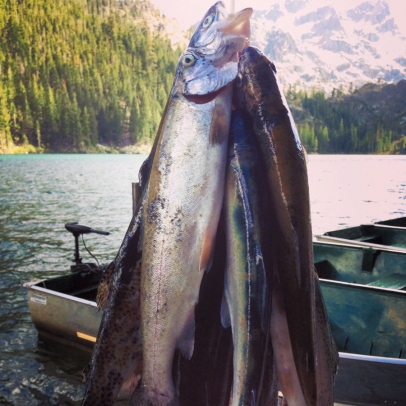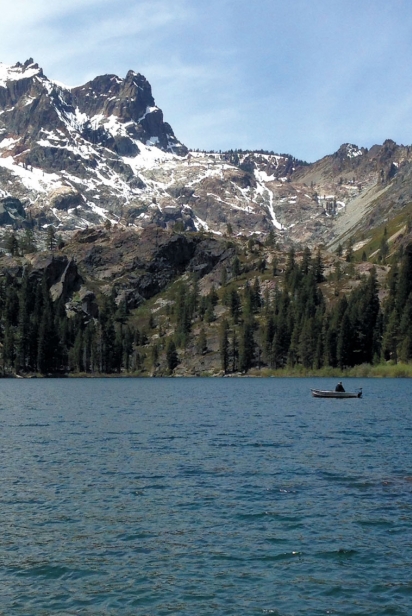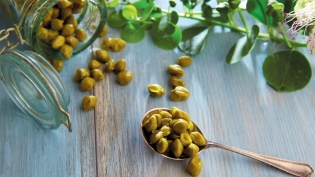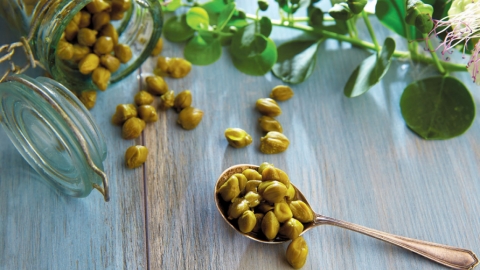The ones that didn't get away
The Big Fish of Sardine Lake
My wife doesn’t like to fish. She’ll tell you she does, but it’s an untruth. Fishing requires calm, quiet and patience for a dinner that may never avail itself. She’s more reminiscent of the tempest now blowing steadily across the waters of California’s Sardine Lake, full of vim and velocity, behavior unsuited to hours of kissing the water with a fly or sinking a weighted hook.
But while she’s settled in front of a roaring fire in our cabin, I’m grabbing at the sides of a small steel skiff as spray blows over the bow, knuckles white with worry, frozen fingers the shade of Arizona turquoise. Whitecaps are whipped to a froth from winds blowing off Tahoe National Forest’s Sierra Buttes mountains, still snow-covered and gleaming in the bright morning sunlight at the lake’s far end. Surely my ill-considered bathing suit and sarong would stay packed for the long weekend ahead.
The 12-foot, motorized skiff was captained by a tall, soft-spoken gentleman several years my junior. A taciturn and knowledgeable man (both of which are, indeed, very fine traits in an outdoorsman), he guided us to cover from the wind’s chill on the far side of Sardine Lake, the mountains looming over us, the only sound the rhythmic pounding of a glacial waterfall cascading down nearby hills.
Settled at 6,200 feet on the lake’s shore, the family-operated Sardine Lake Resort is cloistered under towering pinyon, ponderosa and Jeffrey pines. Named for Sardine, the miner’s mule who tumbled into the lake in the early 1800s, the immaculate waters are fed by natural springs and snowmelt, and surrounded by conifer-covered mountains worthy of Ansel’s lens. Were it ever to become warm enough, swimming is not allowed, as it’s designated a premium fishing lake by the County of Sierra.
All the while scanning for a sighting of the California spotted owl, I took my morning tea and a toke under the branches of a giant sequoia redwood tree whispering wisdom and spewing seed, an aged sultan turbaned in greenery and planted amidst his harem. It is when I’m in nature my voice is heard by my heart; where my creativity breathes; where my innate individuality is woven into the vibrant fabric of the planet. Living amongst others in densely populated sub-urbanity, my humanity wanes. There are so many people now, nosily clamoring for attention in ways sometimes grotesque. The crowded ugliness suffocates. But arriving to Sardine Lake moments before sunset accompanied by the soulful horn of Miles Davis, I’m the only one on Earth. The sky changes with each passing moment, reflecting off the darkening lake, the mountain’s glistening granite now saturated in pastels. Vigor and peace are restored while watching dusk negotiate terms with day and night, its flamboyant hues those found in a child’s watercolor.
The dozen log cabins and cozy dining lodge remain mostly unchanged from their original 1940s construction. Propane tanks, giant pinecones and piles of plywood from long abandoned projects stud the scrubby grounds, while small boats, available for rent, bang against the creaky wooden dock. Vivid blue Stellar’s jays, with their loud screams and punky Mohawk headdresses, terrorize the camp; old trout priests and fishnets handmade from sculpted pine boughs decorate the cabins’ heavy wooden doors.
The small outboard motor had little chance of breaking the lake’s 5mph speed limit as we putt-putted headlong into the wind before finally cutting the motor in a protected nook. Steadying ourselves in the small boat, we experimented casting downwind with spoons, jigs, plugs, spinners and bits of slimy baitfish. We found success with a box of tired night crawlers; worms ripped mercilessly in half and threaded onto tiny, naked, hand-forged hooks.
He jumped.
I gasped loudly, feeling a powerful tug as the hooked fish broke through the dark waters, the flash of his broad reddish stripe like a Hawaiian volcano spewing color from black lava. One of the top sport fish in the country, rainbow trout put up a good fight, often leaping out of the water, as if eyeing its combatant. Also called redband trout, they are native only to the rivers and lakes west of the Rocky Mountains, but have been introduced to baited hooks in waterways throughout the world.
Luminous and contoured like a torpedo, rainbow trout can be hooked by spinning, casting or trolling with either live or dead natural baits. They’ll dine on insects, crustaceans and small fish up to one-third their own length, but they’re true predators and will eat most anything they can get into their gullets.
Members of the salmon family, freshwater rainbow trout typically measure 20–30 inches long, and grow to five pounds in rivers, and up to 20 pounds in lakes. If they escape the dinner plate, they live four to six years. Rainbows thrive in well-oxygenated, cool, clear streams and rivers, and deep lakes with gravelly bottomed tributaries in which to spawn. The more adventurous rainbow will leave freshwater and swim a river to the sea, acquiring both silver markings and the name “steelhead.” They may spend years in the ocean, but wondrously must return to their home stream to spawn.
Their magnificent coloring and markings are varied, depending on age, region and subspecies, but generally rainbows are bluish green or greenish yellow with a streak of rouge along glistening flanks. With a white underbelly and black polka dots on the back and fins, Walt Disney couldn’t have conjured a finer fish.
It wasn’t even mid-morning, yet there were already seven trout tied up and floating in the water behind the narrow boat, keeping chilled in the pristine waters. Sardine Lake is stocked with rainbow trout, and naturalized cutthroat trout have also made their home here. There’s talk from the lodge keeper of eastern brook trout swimming in these waters, but there’s been no proof; nothing but old men repeating rumor, fishing lore traded with the bottle.
Just shy of our daily limit of five fish each, we motored back to shore for our midday repast before returning to lure the remaining fish. As we tied up the boat, I thought about the notion of fishing and hunting limits. They are hardly arbitrary, nor ambiguous. All game species in California require the issuance of an Environmental Impact Report before they can be fished or hunted. Compiled from annual, statewide surveys and monitoring programs, the regulation recommendations (including limits, specific zones, and length of seasons with exact start and end dates) are sent to the California Fish and Game Commission, which votes whether to approve the recommendations or return them for revision.
The surveys are comprised of data gathered from hunting tags, which are purchased by the hunter before he hits the fields and forests, and sport fishing report cards collected from fishermen following their expeditions on the waters. Whether it’s information from fishing open ocean, landlocked lakes or anadromous waters (inland waters accessible to fish migrating from the ocean), this information is crucial for fish and wildlife biologists to create sustainable, science-based quotas for harvest each season.
Even with a deep freezer in the garage, limiting out on anything harvested in the wild always feels greedy to me. Surrounded by piles of fish, it’s too easy to treat them as commodity rather than precious resource. Sardine Lake’s generous limit of five fish per day, any and all days of the year, ensured we’d tire of fish for lunch, fish for dinner and leftover fish hash with eggs for breakfast. So we packed into the cabins like we were hunkering down for the long winter instead of merely a long weekend: onions, pancetta, salt and bags of greens rested alongside bottles of wine, olive oil and bourbon.
The inhabitants of several cabins, friends all, each claimed an evening to host dinner, with the previous night’s feast spilling over into the next day’s lunch. The small, well-equipped kitchens had cast-iron skillets hanging from square-headed nails driven into the log walls. Mismatched plates and silverware, decent wine stems and heavy tumblers for cocktails lined the cupboard shelves. There were grills for fish and gas stoves and ovens for potatoes and bread. The cabin’s original chinked log construction houses kitschy fish lamps, taxidermy, sagging mattresses and plentiful towels, long laundered into sandpaper. Screen doors open onto small porches overlooking the lake, set with pendulous beds for morning reading, afternoon dreaming and bouts of late evening drinking.
Sprawled out together amidst comfortably worn chairs and couches in our toasty living room, doors open wide to the lake, we gorged on a lunch of steaming bowls of leftover spaghettini dense with fiery red chili, green garlic, grated Parmesan and a lavish shaving of bottarga made from salt-cured Sicilian tuna roe smuggled home from a recent trip. A platter of leafy chicories followed, late-in-their-season bitter and laid with pork sliced thick from chops cooked the night prior, topped with baby onions cooked in the fire’s ashes and drizzled with the meat’s unctuous, fatty jus. Even forgoing noontime wine, our cheeks blazed red from the constantly stoked cast-iron stove.
Sated and, finally warmed through, we tucked a few biscotti into our pockets and returned to the boat, anchoring in a different corner of the lake, the mid-afternoon winds having mellowed alongside our early morning ambitions. Digging through the tackle box, I unearthed a small wooden box containing two short, slightly misshapen cigars and matchsticks tucked into a sterling, waterproof match safe with an angler etched on its cover, a prized trinket from an old fishing buddy. We dropped fishing lines and allowed the boat to drift in the breeze, settling back to listen for the call of Peregrine falcons, or spy on a Cassin’s finch with the binoculars, watching the small bird with its red mullet feast on conifer seeds.
Boom!
Our afternoon reverie was short-lived. Both lines hit at the same moment, sending us scrambling to upright. Cursing and laughing, we managed to reel in two beautiful cutthroat trout. Thriving in clear, cold and moderately deep freshwater lakes, and shallow, well-oxygenated rivers and streams with gravelly bottoms, cutthroats are named for the distinctive red coloring on their lower jaws, the moniker first coined by nature writer Charles Hallock in an 1884 article in The American Angler. The species’ scientific name is Salmo clarki in honor of William Clark, who, along with his partner Meriwether Lewis, first described the fish in their journals. The pair was commissioned by Thomas Jefferson to study the flora, fauna and geography of the western United States following the Louisiana Purchase of 1803.
Native to the Pacific Basin, Great Basin and Rocky Mountains, most cutthroat trout are non-migratory and live their lives in fresh water. They’re easily distinguished from rainbow trout as they are a more docile fish, putting up less of a fight before being hauled into the boat. Cutthroats also have teeth on the back of their tongues, which a rainbow does not.At dusk on our final evening on the lake, unwashed and smelling of wood smoke, lake brine and fish, we gathered for our final meal together. Magnums of decades-old Stony Hill Chardonnay from Napa Valley were uncorked while almost-stale baguettes were rubbed with oil and toasted over the open fire to accompany pots of rabbit rillettes, a delicious labor of love harvested from a backyard hutch in Oakland. Platters of the rustic pâté, slathered with spicy French mustard and coarse gray sea salt, were passed around, swiftly disappearing. The trout were cleaned, butterflied and pierced onto pine skewers, which were whittled sharp and speckless, and grilled on mesquite coals until the fish’s flesh pulled easily away from its just-cooked, translucent skin. Topped with a spoonful of sauce made à la minute from Sicilian capers, Meyer lemon, salted Sonoma butter and a splash of the white wine, each mouthful was succulent, sweet and rich; flavors quite remarkable from a fish fed on snowmelt and bugs.
Author’s note: Learning to properly wield a shotgun, stone-sharpen a knife, clean a pheasant or white-tailed deer, grow a spicy radish or bitter chicory and debone the halibut I reeled in allows me the ability to raise a fist against factory farming, to communicate with the cycles and seasons of nature, and with the unusual people who speak in the same, impassioned tongue. Knowing from where my food hails, honoring the beast or plant best by utilizing it in its entirety, feeding myself and those fortunate enough to supper at my table is my practical salvation. It is in the quiet refuge of foraging that I’ve come to glimpse true peace and a gratitude for the richness of the world; and oddly, through hunting and fishing, a greater understanding of compassion and love.









